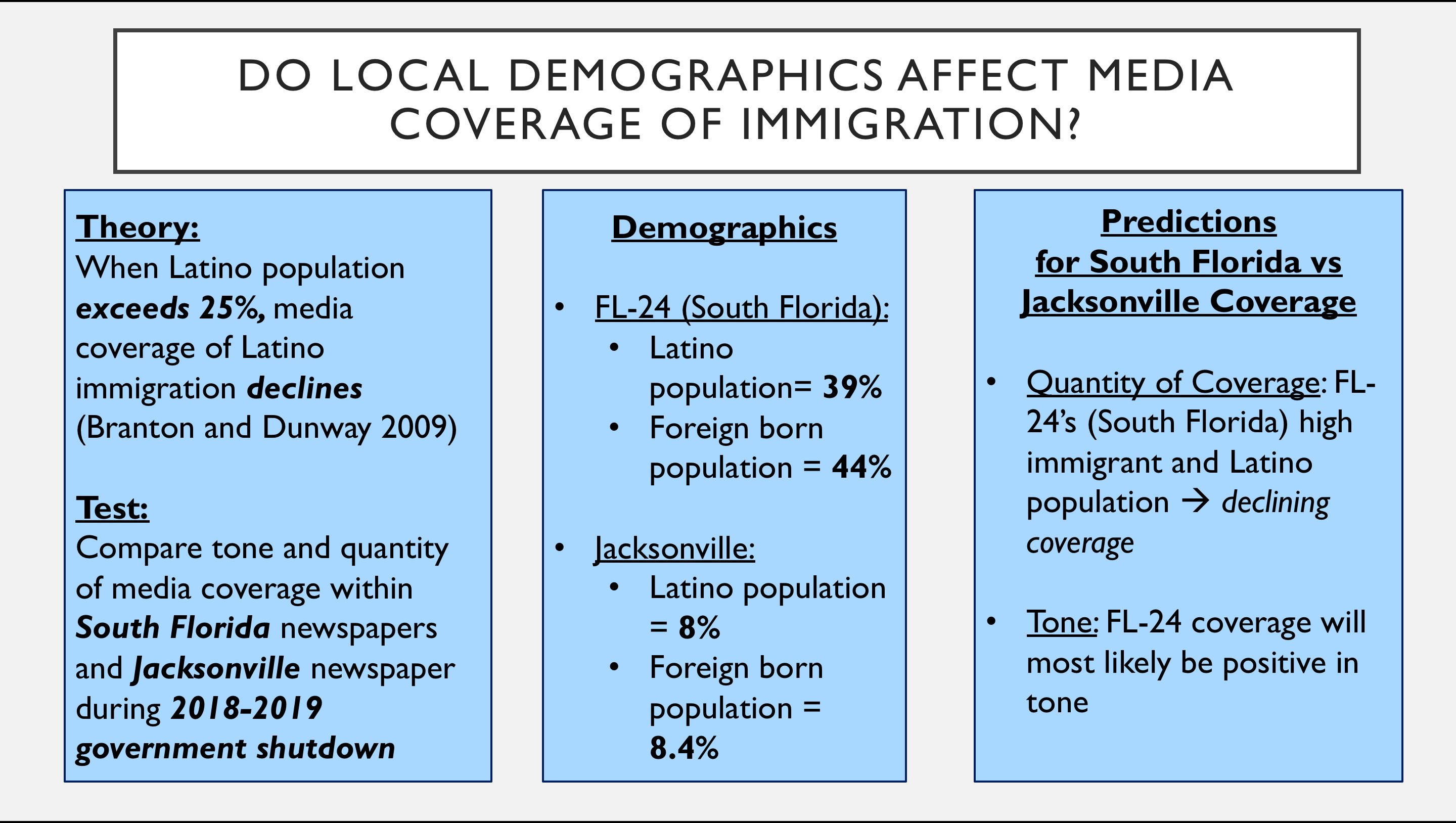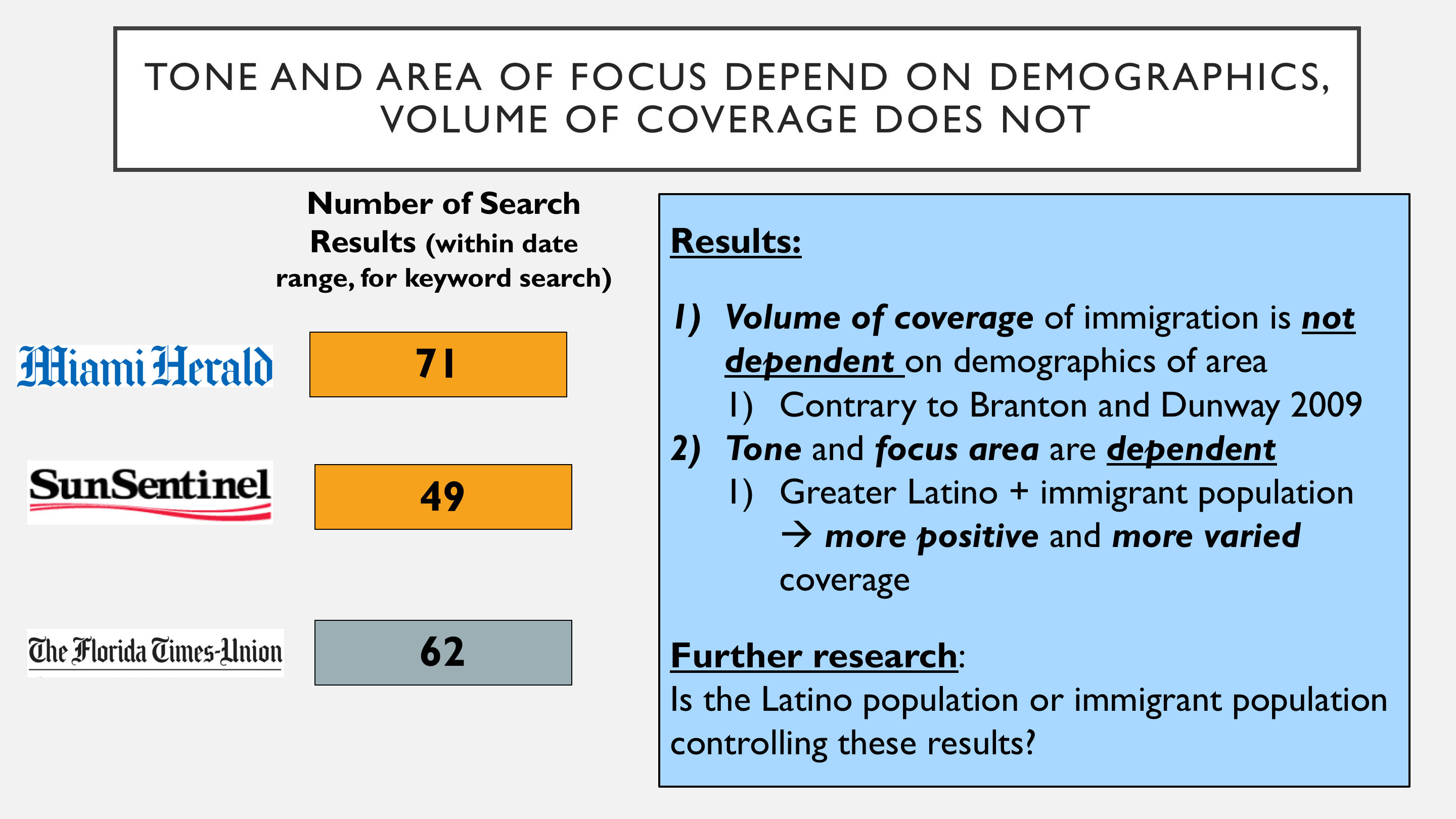

My research investigates whether population demographics affect the likelihood of positive coverage of immigration. This research tests the theory that Branton and Dunway (2009) present in their analysis of media coverage on immigration. One of the lesser emphasized results of their study is that when the Latino population exceeds 25%, the coverage of Latino immigration declines. I will apply this theory to FL-24, which has a Latino population of nearly 40% by comparing media coverage of immigration in South Florida (where FL-24 is located) with that of Jacksonville, where the Latino population is just 8%. In addition, the percentage of foreign-born population in FL-24 is 44%, and the foreign-born population in Jacksonville is 8.44%.
I will test not just the amount of coverage, as Branton and Dunway’s theory covers. I will also survey the tone and differing focus areas of the two areas’ newspaper coverage. I predict that South Florida, with a higher Latino and immigrant population, will have both a higher percentage of pro-immigrant news stories. Based on Branton and Dunway’s research, FL-24 will have a decreased volume of coverage on immigration. However, I predict based on the high immigrant population, the South Florida newspapers will be more positive in tone when covering immigration issues.

The data that will be analyzed is articles pertinent to immigration during the 2018-19 federal government shutdown in two South Florida newspapers, The Miami Herald and The Sun-Sentinel, and the Jacksonville newspaper, The Florida Times-Union. Using the database Newsbank, I went through all three sources and searched for articles with the search term “”immigrant” OR “immigration” OR “immigrants”, border wall security shutdown” within the date range of 12/11/2018 and 1/31/2019. This allows us to find the relevant articles that mention immigration within the time period, so as to avoid articles that are just about the government shutdown but have no perspective on immigration. Then, all relevant articles were downloaded, excluding editorials, as the focus of the research is how the immigration issue is covered in news articles, not how the readers who write in to the newspapers feel about immigration.
The selected articles are then coded for their tone and focus area and for all articles, the results are recorded in an Excel spreadsheet. To perform the coding for the articles, I analyzed how immigrants are characterized or what context they are described in within the articles. Articles are coded as positive in tone if immigrants are characterized as hard-working, contributing to society, being “legal” or living legally. In addition, if immigrants are mentioned in the context of the DREAM Act, humanitarian issues (such as immigrant deaths), families, or ‘vulnerable’ populations (young, old, or women), the article is coded as positive. Lastly, articles that are specifically for the purpose of helping immigrants with legal challenges are coded as positive. On the other hand, articles are coded as negative if they describe immigrants as illegal or living illegally, describe immigrants in the context of crimes (including gangs or smugglers), or describe immigration as a problem or crisis. Neutral articles are those in which immigration is only mentioned in one or two lines of the article or where the article reports only series of events and all opinions are quoted from other sources, such as political party leaders.

The results of the analysis show that in South Florida, with a large immigrant and Latino population, the coverage of immigration is much more positive than the coverage in Jacksonville, with a low immigrant and Latino population. The Miami Herald and the Sun Sentinel both have greater than 50% positive articles. The Florida Times Union, however, has primarily neutral articles solely covering the series of events during the government shutdown, and only has 15% positive articles. In terms of focus area, for all three sources, partisanship (primarily stories about national politics) is the majority of the articles, which makes sense due to the coverage of the national debate over the government shutdown. However, the South Florida newspapers have a much broader range of coverage for different focus areas, including international politics (mostly stories about Venezuelan politics) and news within the local immigrant community.

My research contradicts the findings of Branton and Dunway, who argue that coverage of immigration will decrease with a greater than 25% Latino population. In fact, in terms of the volume/quantity of coverage, the number of articles that fit the search terms are not dependent on location; the Miami Herald and Sun Sentinel produced 71 and 49 articles respectively, while the Florida Times Union has 62 stories that fit the search terms and date range. However, the tone of the coverage differed substantially between the two different areas of Latino and immigrant concentrations. Additional research can focus on determining which of the two factors contributed to the positive coverage of immigration – the Latino population or the immigrant population. Overall, these findings suggest that although the amount of coverage is not based on population – especially for a politically contentious issue like immigration during a politically contentious period like the government shutdown – the tone of that coverage in media varies significantly based on the population demographics.